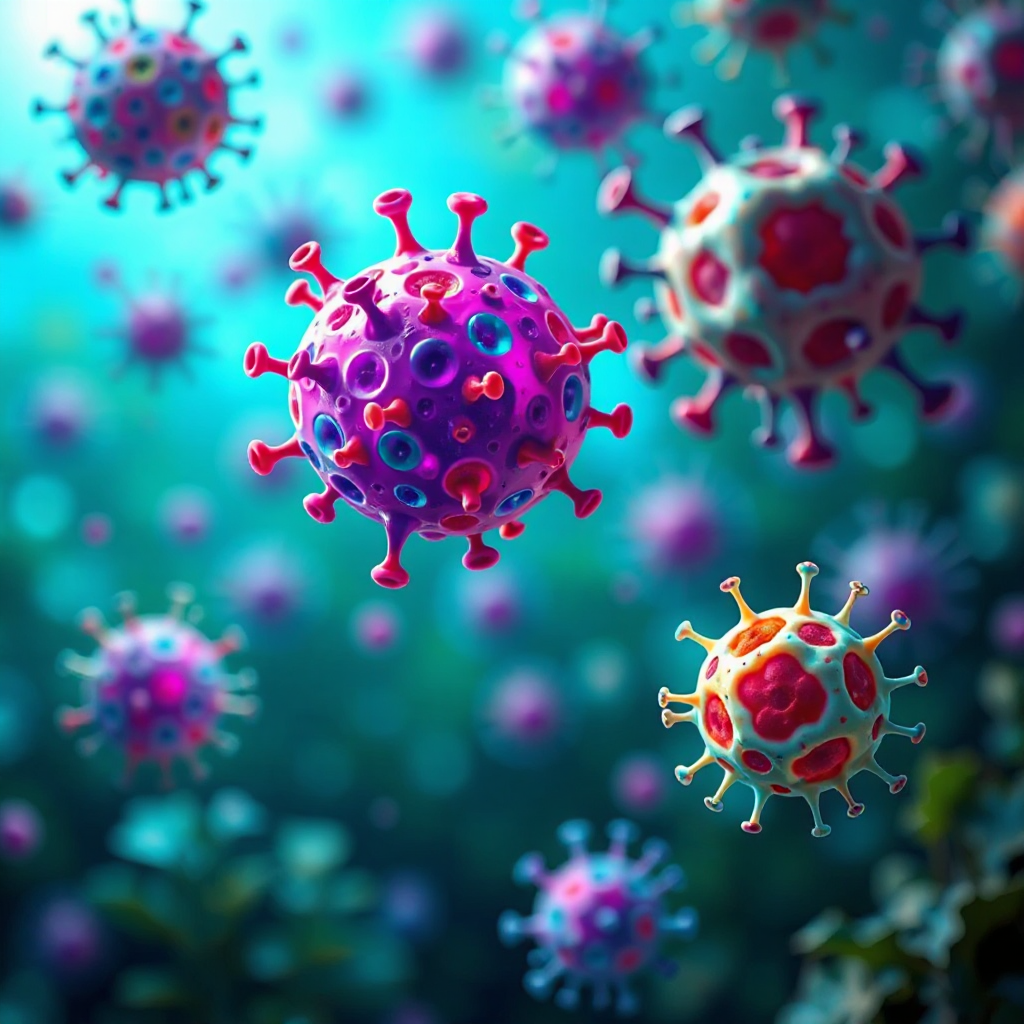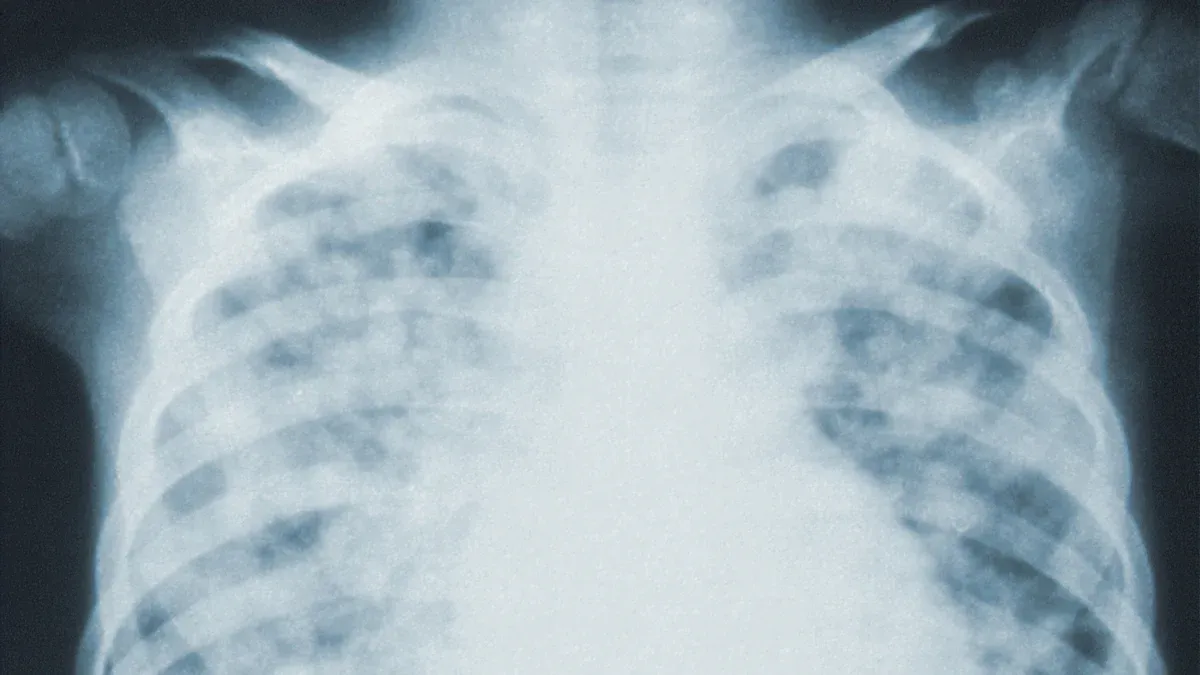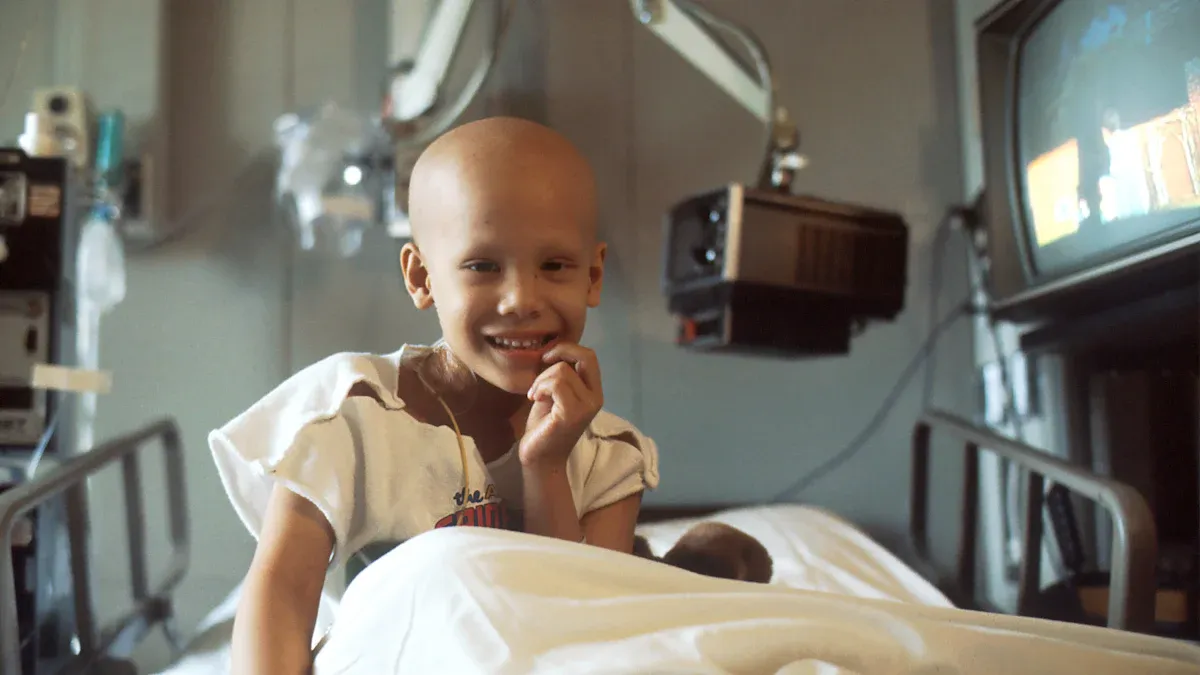What is Pleuropulmonary Blastoma and Its Symptoms

Pleuropulmonary blastoma is a rare and aggressive childhood cancer that develops in the lungs or the pleural cavity. It primarily affects children under the age of five and belongs to a group of malignant mesenchymal tumors. These tumors often show localized growth but can behave aggressively, making early detection crucial.
You should know that pleuropulmonary blastoma has different subtypes, ranging from benign cystic forms to solid, malignant tissue. Advances in diagnostic techniques have improved early detection, but raising awareness among parents and healthcare professionals remains essential. Early recognition of symptoms can lead to timely interventions and better outcomes for affected children.
Key Takeaways
Pleuropulmonary blastoma is a rare cancer in young kids under five. It mainly affects the lungs or the space around them.
Symptoms include a long-lasting cough, trouble breathing, and losing weight without reason. Spotting these early helps with better treatment.
Changes in the DICER1 gene can raise the risk of this cancer. Genetic testing can find kids who might get it.
Treatment includes surgery, chemotherapy, and sometimes radiation. The plan depends on the tumor's type and how serious it is.
Regular check-ups are important to track healing and catch any return of the cancer. This helps ensure the best results over time.
What is Pleuropulmonary Blastoma?

Definition and Overview
Pleuropulmonary blastoma is a rare type of childhood cancer that develops in the lungs or pleural cavity. It primarily affects children under the age of five and is classified as a malignant mesenchymal tumor. This cancer is unique because it can appear in different forms, ranging from cyst-like structures to solid tumors. The type of tumor often determines how aggressive the disease is and the treatment approach needed. Early diagnosis plays a critical role in improving outcomes for children with this condition.
Types of Pleuropulmonary Blastoma
Pleuropulmonary blastoma is divided into three main types based on its structure and severity. Each type has distinct characteristics and affects children at different ages.
Type I (Cystic)
Type I tumors are purely cystic and typically diagnosed in infants around 10 months old. These tumors resemble congenital lung cysts and have a better prognosis compared to other types. Surgical removal is often sufficient, and additional treatments like chemotherapy are rarely needed.
Type II (Mixed)
Type II tumors combine cystic and solid components. They are usually diagnosed at a median age of 34 months. These tumors are more aggressive than Type I and may require a combination of surgery and high-dose chemotherapy. The presence of solid parts makes them more challenging to treat.
Type III (Solid)
Type III tumors are entirely solid and represent the most aggressive form of pleuropulmonary blastoma. They are typically diagnosed at a median age of 44 months. These tumors often spread to other parts of the body, making treatment more complex. Aggressive interventions, including surgery and chemotherapy, are necessary to manage this type.
Type | 5-Year Overall Survival Rate | Treatment Approach |
|---|---|---|
I | 98% | Surgical resection, rarely adjuvant chemotherapy |
II | 71% | Aggressive intervention, lobectomy or pneumonectomy, high-dose adjuvant chemotherapy |
III | 53% | Aggressive intervention, high-dose adjuvant chemotherapy |
Who is Affected?
Pleuropulmonary blastoma primarily affects children under the age of five. Infants and toddlers are the most vulnerable, with the type of tumor often correlating with their age. Genetic factors, such as mutations in the DICER1 gene, significantly increase the risk of developing this cancer. If you have a family history of DICER1 syndrome, your child may have a higher likelihood of being affected. Early genetic testing and regular monitoring can help detect the disease at an earlier stage.
Symptoms of Pleuropulmonary Blastoma

Common Symptoms
Recognizing the symptoms of pleuropulmonary blastoma early can make a significant difference in treatment outcomes. Children with this condition often experience a range of respiratory and systemic symptoms. Some of the most commonly reported symptoms include:
Difficulty breathing or shortness of breath
Fever, which may indicate an underlying infection
Wheezing sounds during breathing
Pain in the chest or abdomen
Frequent lung infections, such as pneumonia
Loss of appetite and unexplained weight loss
Fatigue or tiredness
These symptoms can sometimes mimic those of common respiratory illnesses, making it challenging to identify pleuropulmonary blastoma in its early stages. For example, Type I tumors may resemble congenital lung cysts, which can delay proper diagnosis. If your child shows any of these signs, it’s essential to monitor their condition closely.
Note: Symptoms like persistent cough, chest pain, or difficulty breathing should never be ignored. Early medical evaluation can help rule out serious conditions and ensure timely treatment.
When to Seek Medical Attention
You should seek immediate medical attention if your child exhibits any of the following warning signs:
A cough that persists or worsens over time
Severe chest pain or discomfort
Difficulty breathing or shortness of breath
Wheezing that doesn’t resolve
Unexplained weight loss or loss of appetite
Recurrent fevers or signs of lung infections
These symptoms could indicate pleuropulmonary blastoma or another serious condition requiring prompt intervention. Consulting a healthcare professional early can lead to a more accurate diagnosis and better outcomes.
Causes of Pleuropulmonary Blastoma
Understanding the causes of pleuropulmonary blastoma can help you recognize potential risk factors and take preventive measures when possible. While the exact cause of this rare childhood cancer remains unclear in some cases, researchers have identified several contributing factors.
Genetic Factors
Genetic mutations play a significant role in the development of pleuropulmonary blastoma. One of the most common genetic links is a mutation in the DICER1 gene. This mutation is found in approximately 50-75% of patients diagnosed with this condition. The DICER1 gene is responsible for regulating cell growth and division. When it mutates, it can lead to abnormal cell growth, increasing the risk of tumors like pleuropulmonary blastoma.
Studies have also shown that about 70% of individuals with this cancer carry a DICER1 mutation. This mutation is not limited to pleuropulmonary blastoma but is part of a broader syndrome that raises the risk of other tumors. If your family has a history of DICER1-related conditions, genetic testing can help identify potential risks early.
Familial and Hereditary Links
Family history plays a crucial role in the occurrence of pleuropulmonary blastoma. If a close relative has been diagnosed with this cancer or carries a DICER1 mutation, your child may have a higher likelihood of developing it. DICER1 syndrome, a hereditary condition, is often associated with familial cases of this disease. Genetic testing is recommended for families with a known history of DICER1 mutations. This testing can help identify at-risk individuals and guide early monitoring or intervention.
Environmental or Unknown Factors
In some cases, the cause of pleuropulmonary blastoma remains unknown. While genetic factors are the primary contributors, environmental influences may also play a role. Exposure to certain environmental elements has been noted as a potential risk factor. However, many cases occur sporadically without any identifiable genetic or environmental triggers. This unpredictability highlights the importance of regular health check-ups and early symptom recognition.
Treatment Options for Pleuropulmonary Blastoma
Surgical Interventions
Surgery is often the first step in treating pleuropulmonary blastoma. Doctors aim to remove the tumor entirely, which is crucial for a successful outcome. Depending on the tumor's size and location, the procedure may involve removing a lobe of the lung (lobectomy). In some cases, chemotherapy is used beforehand to shrink the tumor, making surgery more effective.
Key surgical approaches include:
Complete resection of the tumor to prevent recurrence.
Lobectomy, where the affected lung lobe is removed.
Additional chemotherapy after surgery to eliminate any remaining cancer cells.
For Type I tumors, surgery alone is often sufficient. However, Type II and III tumors require more aggressive surgical methods due to their higher risk of spreading. Early surgical intervention can significantly improve survival rates.
Chemotherapy
Chemotherapy plays a vital role in treating more advanced types of pleuropulmonary blastoma. It uses powerful drugs to destroy cancer cells and prevent them from growing. For Type II and III tumors, chemotherapy is typically combined with surgery to reduce the risk of recurrence.
Doctors often use high-dose chemotherapy regimens, including anthracycline-based drugs, which have proven effective. These treatments target cancer cells throughout the body, addressing any that may have spread beyond the lungs. While chemotherapy can cause side effects like nausea and fatigue, it remains a cornerstone of treatment for aggressive cases.
Radiation Therapy
Radiation therapy is less commonly used for pleuropulmonary blastoma but may be recommended in specific situations. It involves using high-energy rays to target and destroy cancer cells. Doctors may suggest radiation if surgery cannot completely remove the tumor or if the cancer has spread.
Considerations for radiation therapy:
It is typically reserved for high-risk patients or those with residual tumors.
Doses range from 30 to 54.8 Gy, depending on the tumor's size and location.
Long-term risks, such as heart damage, limit its use in children.
Studies show that radiation therapy does not always improve survival rates, so it is used selectively. Your doctor will weigh the potential benefits and risks before recommending this option.
Supportive Care and Follow-Up
Supportive care plays a vital role in helping children with pleuropulmonary blastoma manage their treatment journey and recover effectively. A pediatric oncologist leads the care team, working closely with specialists to address the unique needs of each child. This team often includes pediatricians, surgeons, nurses, social workers, and psychologists. Their combined expertise ensures that your child receives comprehensive care tailored to their physical and emotional well-being.
You may encounter a wide range of professionals during your child’s treatment, such as:
Pediatric surgeons and radiation oncologists
Pathologists and medical oncologists
Rehabilitation specialists and oncology nurses
Social workers and child-life professionals
Psychologists and nutritionists
This multidisciplinary approach ensures that every aspect of your child’s health is addressed, from managing side effects to providing emotional support.
Long-term health outcomes can vary depending on the type of tumor and the treatment received. For example, children with Type II tumors have a 71% overall survival rate, while those with Type III tumors face a lower rate of 53%. Recurrence remains a concern, with a 37% event-free survival rate. Some children may experience physical challenges, mood changes, or cognitive difficulties after treatment. The risk of developing secondary cancers or other conditions also exists.
Outcome Type | 5-Year Event-Free Survival Rate | Overall Survival Rate |
|---|---|---|
Recurrent Disease | 37% | 37% |
Type II | 59% | 71% |
Type III | 37% | 53% |
Follow-up care is essential for monitoring your child’s recovery and detecting any signs of recurrence. Regular check-ups and diagnostic tests help evaluate the effectiveness of treatment and track any changes in your child’s condition. These ongoing assessments provide peace of mind and ensure that any issues are addressed promptly.
Tip: Staying proactive with follow-up appointments and maintaining open communication with your child’s care team can significantly improve long-term outcomes.
Understanding pleuropulmonary blastoma can help you recognize its symptoms, causes, and treatment options. This rare childhood cancer often presents with breathing difficulties, chest pain, or persistent cough. Genetic factors, such as DICER1 mutations, play a significant role in its development. Treatment advancements, including multimodal approaches like chemotherapy regimens used for sarcomas, have improved survival rates. For instance, children with Type II tumors now have a 71% overall survival rate, while those with Type III tumors have a 53% rate.
Early diagnosis remains critical. Consulting a healthcare professional ensures timely intervention and personalized care. Ongoing research in genomics and targeted therapies offers hope for better outcomes. With these advancements, children diagnosed with pleuropulmonary blastoma have a brighter future.
FAQ
What is the survival rate for pleuropulmonary blastoma?
The survival rate depends on the tumor type. Type I has a 98% survival rate, Type II is 71%, and Type III is 53%. Early diagnosis and treatment improve outcomes significantly.
Can pleuropulmonary blastoma be prevented?
You cannot prevent pleuropulmonary blastoma entirely. However, genetic testing for DICER1 mutations in families with a history of the condition can help identify risks early. Regular monitoring ensures timely intervention.
How is pleuropulmonary blastoma diagnosed?
Doctors use imaging tests like X-rays, CT scans, or MRIs to detect tumors. A biopsy confirms the diagnosis by analyzing tissue samples. Genetic testing may also identify DICER1 mutations.
Are there long-term effects of treatment?
Some children experience physical or cognitive challenges after treatment. Regular follow-ups help manage these effects. The risk of secondary cancers or recurrence also exists, so ongoing monitoring is essential.
What should you do if your child shows symptoms?
Seek medical attention immediately if your child has persistent cough, chest pain, or breathing difficulties. Early evaluation by a healthcare professional ensures accurate diagnosis and timely treatment.
Tip: Keep a record of your child’s symptoms to share with the doctor. This helps in identifying patterns and making a quicker diagnosis.
See Also
Exploring Hepatoblastoma: Key Symptoms You Should Know
Burkitt's Lymphoma: Understanding Symptoms and Their Impact
A Comprehensive Guide to Blastoma and Its Variants
Lymphoplasmacytic Lymphoma: Symptoms and Important Insights
Acute Lymphoblastic Leukemia: Recognizing Symptoms and Signs
